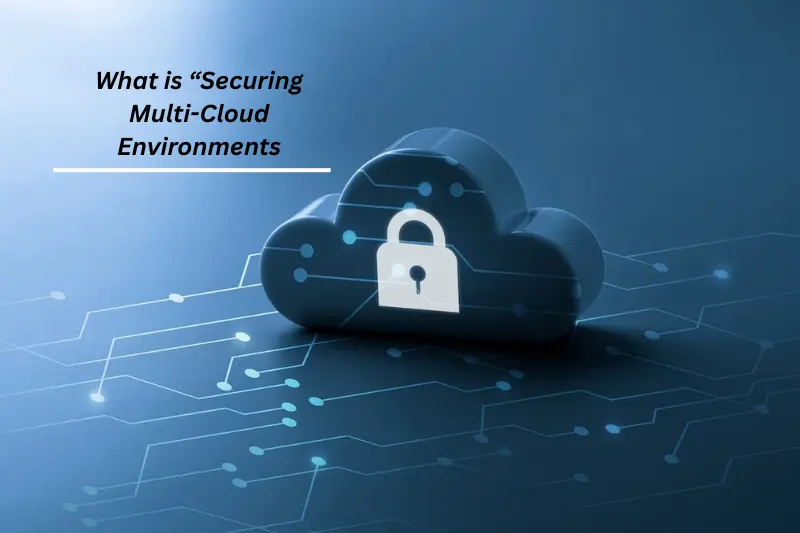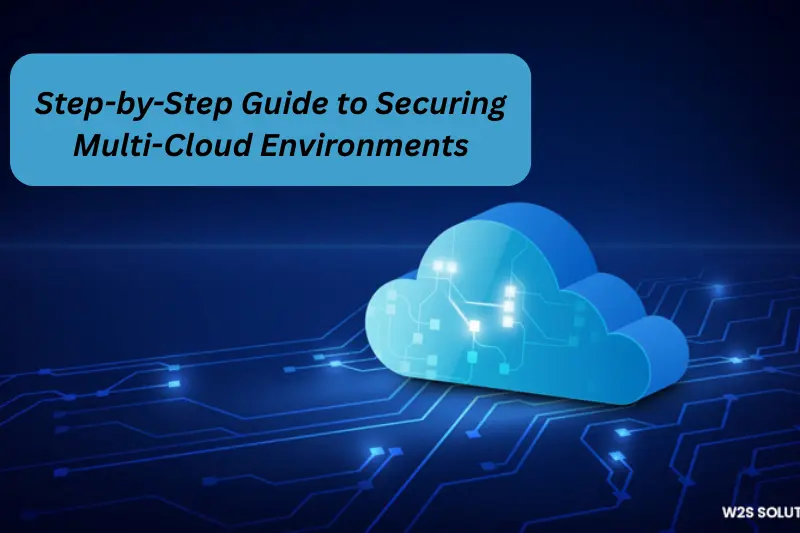Introduction
In today’s digital world, many businesses are moving to multi-cloud environments to boost performance, reduce costs, and avoid relying on just one cloud provider. But with this flexibility comes a new set of challenges—security being the biggest one. That’s why Securing Multi-Cloud Environments – Strategies for Safer & Smarter Cloud Protection is more important than ever in 2025. This blog will guide you through the risks, smart strategies, and practical tips to help keep your cloud data and operations safe across all platforms.
What is “Securing Multi-Cloud Environments – Strategies for Safer & Smarter Cloud Protection”?

Securing Multi-Cloud Environments – Strategies for Safer & Smarter Cloud Protection refers to the process of protecting data, applications, and services that are spread across multiple cloud providers like AWS, Microsoft Azure, Google Cloud, and others.
Instead of relying on just one cloud, many organizations use a combination of platforms to improve performance, save costs, and reduce dependency on a single vendor. However, this setup also increases the chances of security risks such as data breaches, misconfigurations, or unauthorized access.
To prevent these risks, businesses need smart, consistent, and automated security strategies that work across all cloud environments. These strategies include centralized monitoring, identity and access management, encryption, compliance checks, and regular security audits.
In short, this approach helps businesses stay safe, stay smart, and stay in control—no matter how many clouds they use.
Why Securing Multi-Cloud Environments is Important
As more organizations adopt multi-cloud strategies in 2025, securing these environments has become a top priority. Here’s why it matters:
Increased Risk of Cyberattacks
- Multiple Entry Points for Hackers
Each cloud platform has its own access controls and settings, increasing the risk of gaps hackers can exploit. - Misconfigurations Are Common
When managing several platforms, it’s easy to misconfigure settings, leaving data exposed to threats. - Broader Attack Surface
Using multiple clouds means more apps, APIs, and services, all of which can be targeted by attackers.
Compliance and Data Privacy
- Different Clouds, Different Rules
Each provider may have different compliance standards, making it harder to manage regulations across platforms. - Sensitive Data Spread Across Platforms
Customer and business data may be stored in various locations, increasing privacy concerns if not properly protected. - Auditing Becomes More Complex
Tracking user activity and system changes across multiple clouds makes regulatory audits more difficult to manage.
Lack of Visibility and Control
- Difficult to Monitor Everything
When data and applications are spread out, it’s hard to get a clear view of what’s happening across all platforms. - Inconsistent Security Policies
Different tools and settings may lead to inconsistent security practices across your cloud environments. - Harder to Detect Threats in Real-Time
Without centralized monitoring, identifying and reacting to threats quickly becomes a challenge.
Business Continuity and Trust
- Downtime Can Spread Across Clouds
A security incident in one cloud can impact operations in others, affecting uptime and productivity. - Loss of Customer Trust
A data breach, even in just one cloud provider, can damage your reputation and customer confidence. - Financial Losses and Legal Risks
Security failures can result in regulatory fines, lawsuits, and significant financial damage to the business.
Growing Complexity in Cloud Management
- More Tools, More Confusion
Each cloud has different interfaces and tools, making it harder to manage security consistently. - Lack of Skilled Security Talent
Specialists who understand multi-cloud security are in high demand, making it tough for businesses to stay protected. - Need for Consistent Strategy
A clear and unified approach is essential to prevent gaps, overlaps, and inefficiencies in your security setup.
Step-by-Step Guide to Securing Multi-Cloud Environments

Securing a multi-cloud setup requires a structured and consistent approach. Follow these steps to protect your data, systems, and users across all platforms.
Step 1: Identify All Cloud Assets and Services
- Start by making a complete inventory of every cloud provider, service, app, and data storage location your business uses.
- This helps you understand where potential risks exist and what needs to be secured.
Step 2: Set Unified Security Policies
- Establish standard security policies that apply to all clouds you use—like password rules, access levels, and encryption practices.
- This keeps your security consistent, no matter which platform you’re working with.
Step 3: Centralize Identity and Access Management (IAM)
- Use a centralized IAM tool to manage user roles, permissions, and multi-factor authentication across all clouds.
- It reduces the risk of unauthorized access and makes user management much easier.
Step 4: Implement Central Monitoring and Logging
- Use a cloud security monitoring tool or SIEM system to track all cloud activities in one place.
- This allows you to detect unusual behavior, threats, or errors quickly and respond fast.
Step 5: Automate Security with Tools
- Use automation tools like Infrastructure as Code (IaC), CSPM, and CI/CD pipelines to apply and enforce security settings.
- Automation reduces human error and ensures security settings remain consistent.
Step 6: Encrypt Data in Transit and at Rest
- Make sure all sensitive data is encrypted—both when it’s stored and when it’s being transferred.
- Use encryption keys that you control to add an extra layer of protection.
Step 7: Conduct Regular Security Audits
- Schedule internal audits and third-party assessments to check for misconfigurations, vulnerabilities, and policy gaps.
- This helps you fix issues early before they become serious problems.
Step 8: Maintain Compliance Across Platforms
- Ensure all cloud services comply with industry standards like GDPR, HIPAA, or ISO 27001.
- Use automated compliance tools to track, report, and fix violations across your environments.
Step 9: Train Teams on Multi-Cloud Security Best Practices
- Educate your IT, DevOps, and security teams on the unique risks of multi-cloud environments.
- Regular training ensures everyone follows the same secure practices and understands their responsibilities.
Step 10: Prepare an Incident Response Plan
- Develop a clear and fast response plan for cloud-specific incidents like data breaches or system failures.
- Make sure the plan covers all your cloud vendors and outlines roles, steps, and recovery actions.
Advantages and Disadvantages of Securing Multi-Cloud Environments
| Advantages | Disadvantages |
| Better Protection Across All Platforms A strong security strategy ensures that data, apps, and services are safe, no matter which cloud provider is used. | Increased Complexity Managing security across multiple platforms requires more tools, expertise, and coordination. |
| Improved Compliance and Governance Centralized security controls help you meet industry regulations and keep up with changing compliance standards. | Higher Costs for Tools and Training Investing in advanced security tools and skilled staff can be expensive for some organizations. |
| Reduced Risk of Data Breaches Consistent monitoring, access controls, and encryption significantly lower the chances of unauthorized access or data loss. | Skills Gap in Multi-Cloud Security Finding professionals who understand the security needs of all major cloud platforms can be challenging. |
| Faster Threat Detection and Response With centralized tools and automated alerts, threats can be identified and addressed more quickly. | Risk of Inconsistent Policies Without proper automation, applying the same security rules across all platforms can lead to mistakes and gaps. |
| More Control and Visibility You get a clear, real-time view of your entire cloud environment, making it easier to manage and secure. | Ongoing Maintenance Required Security needs regular updates, audits, and improvements—especially when managing different cloud environments. |
Common FAQs on Securing Multi-Cloud Environments
Q1. What is a multi-cloud environment?
A multi-cloud environment means using more than one cloud provider—like AWS, Azure, or Google Cloud—for different services in your business.
Q2. Why do companies use multi-cloud?
It helps avoid depending on one provider, improves performance, and gives flexibility in choosing the best services from each platform.
Q3. Why is securing multi-cloud important?
Using different clouds means different rules and settings. Without proper security, your data could be exposed or at risk of attacks.
Q4. Who is responsible for cloud security?
Security is a shared responsibility. Cloud providers secure the platform, but you must protect your data, apps, and settings.
Q5. What are the main risks in multi-cloud?
Common risks include misconfigured settings, weak access controls, data leaks, and lack of visibility across all cloud services.
Q6. How can I make my multi-cloud setup secure?
Use strong access controls, encrypt your data, monitor activity, automate security policies, and regularly check for weaknesses.
Q7. Is multi-cloud more secure than single cloud?
Not necessarily. It can be more secure if managed well, but it also adds complexity. The key is consistent and smart security practices.
Q8. Do I need special tools for multi-cloud security?
Yes. Using centralized tools for monitoring, identity management, and policy enforcement makes it easier to manage security across platforms.
Conclusion
Securing multi-cloud environments is no longer optional—it’s essential. As businesses use more than one cloud provider, staying protected means using smart strategies like central monitoring, strong access control, and consistent policies. With the right tools and team awareness, you can keep your data safe and your operations running smoothly across all platforms.
Bonus Points
- Adopt Zero Trust Architecture
Never automatically trust any user or device. Always verify before granting access, no matter where the request comes from. - Use Multi-Cloud Security Platforms
Tools like Prisma Cloud, Microsoft Defender for Cloud, or Lacework offer unified security across multiple cloud providers. - Automate Compliance Reporting
Automated tools can track and report compliance issues in real-time, saving time and reducing human error. - Keep Backup and Recovery Plans Ready
Always have secure, encrypted backups across clouds, and test your disaster recovery plan regularly. - Review and Update Policies Often
Cloud threats evolve quickly. Keep your security settings, permissions, and policies updated regularly to stay protected.




